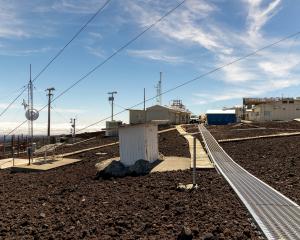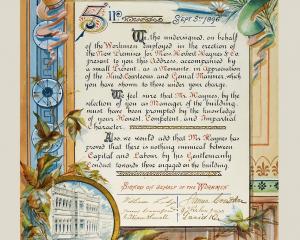Their tribal area is the biggest in New Zealand. They have turned a $170 million Treaty Settlement into a $1 billion-and-climbing wealth fund. And they are about to stage a massive festival in Dunedin. But success is stirring some searching questions about what it means to be Ngai Tahu, writes Bruce Munro.
The day began, not on a marae, but with coffee in the Octagon.
Ordering a latte in the early morning sunshine is Kitty Brown, the surprisingly calm co-ordinator of Ngai Tahu's imminent Hui-a-Iwi; a massive, all-of-iwi festival to be held next weekend in Dunedin's Town Hall and across the city.
The three-day gathering of Ngai Tahu from throughout Te Wai Pounamu and beyond is being billed as an opportunity for the 50,000-member iwi with a growing regional and national presence, and a net worth of more than $1 billion, to celebrate and express its culture and identity.
It seems the ideal moment to ask who or what is Ngai Tahu? What does it mean to be a member of this once-ridiculed but now feted tribe?
The iwi is composed of 18 geographically based runanga, spread over 80% of the South Island, which together make up Te Runanga o Ngai Tahu.
The answer will lie not in one voice, but in the overlapping and perhaps even conflicting views of Ngai Tahu throughout their rohe, their tribal area.
So, beginning in the centre of Dunedin, today's conversations will also take in each of the runanga hosting the Hui-a-Iwi: Moeraki, Kati Huirapa ki Puketeraki and Otakou.
For Mrs Brown, exploring the notion of ''being Tahu'' is comparatively recent, and ongoing.
Raised in Kaiapoi, she spent many school holidays with her auntie at ''the kaik'' near the end of Otago Peninsula.
For a long time, however, she has harboured some guilt about her Ngai Tahu identity.
''Am I not really Maori because I don't have dark skin and I don't have a piupiu and poi?''
Mrs Brown, who is Ngai Tahu through her mother's line, explains.
Then recently, she was given a different perspective.
Through the process of colonisation, no one family could keep hold of all elements of Ngai Tahu culture, she was told.
''So we kept the bits we could. That really resonated with me,'' Mrs Brown says.
She may not have been taught te reo Maori or spent much time on marae, but her family had held on to its titi (muttonbird) and tuna- (eel) gathering traditions.
''That was seasonal, migrational stuff that my family would do. So, my connection lies with those practices.''
She says working for Ngai Tahu is ''a weird mash-up of tribal tikanga meets Western business practice''.
''It's cool. I love it.''
Two hours later and 80km north of Dunedin, the same questions are being addressed by Nola Tipa, of Moeraki.
For her, the parts are integral to the whole.
Mrs Tipa is a member of Te Runanga o Moeraki.
At the Hui-a-Iwi, she is overseeing the many health-focused stalls and ensuring visiting kaumatua (seniors) are well cared for.
''I wanted to be involved because for me it is all about the reinvigoration of who we are as a people,'' she says while looking out across the picturesque bay she has been regularly returning to since she was a child and has called home for the past four years.
Following the tikanga and kawa (protocols and rules) of this area, and trying to live by what is tika and pono (true and correct) has always been important.
She most closely identifies with being a member of the extended Tipa whanau, and is busy developing ways for Ngai Tahu with links to Moeraki to strengthen their connections with the marae and the whenua, the land.
''The bigger [iwi] picture is made up of the bits. And te whanau Tipa is one of those bits,'' she explains.
''If I am talking to other big groups, then I will say, us Tahus ... but in my everyday life, I am just a Tipa from Moeraki.''
• Half an hour back down the road, Suzanne Ellison, who is manager of the Karitane-based (and southern dialect-strong) Kati Huirapa Runaka ki Puketeraki, picks up the thread.
Being Kai Tahu is ''such an important part of the way we live'' for Ms Ellison who was raised in Karitane, a stronghold of cultural practices and land claim action throughout last century.
At the same time, she is also proud of her English and Irish heritage.
Perhaps a distinctive characteristic of the iwi is encapsulated in its whakatauki, its proverbs, she says.
An oft-repeated saying within Kai Tahu circles is ''Mo tatou, a, mo ka uri, a, muri ake nei'' - For us and our children after us.
The Kai Tahu sense of identity is growing stronger, Ms Ellison says.
''We had four or five generations of people who, if they weren't involved in the Kai Tahu claims issues - the remnant that was really the heart of Kai Tahu - then they were on the fringes and subsumed into general society and may not have felt they could really hold their heads up as Ngai Tahu people.
''But I think that since settlement that has changed and is changing ... It's amazing what a hunger and thirst there has been for knowledge, to be involved, to be able to be proud of your iwi, even if you feel slightly separated from it.''
The plan had been to then drive to Otakou, on Otago Peninsula, to talk to Mr Potiki.
But he has been unwell, so a telephone conversation will have to suffice.
As it turns out, neither ill-health nor physical distance can dampen his views and his willingness to express them.
Ngai Tahu means the people of Tahu; that is, Tahu Potiki, after whom he is named, and from whom came the two related tribes who moved into the South Island about 265 to 315 years ago.
They fought, married and merged with Kati Mamoe who had previously done the same with Waitaha.
The first strong sense of being a united South Island-wide iwi probably did not emerge until Te Rauparaha, of Ngati Toa, in the North Island, began his musket-fuelled raids in 1830, Mr Potiki says.
''Before his invasion, the hapu were fighting each other. But as soon as he struck, they banded together,'' he says.
''All the warriors would get together each year and shoot up to the northern part of the South Island to defend the boundary against Te Rauparaha. There was a season when war parties would get on the hoof.
''Tensions still existed and still do exist [between Ngai Tahu hapu], but from that time the sense of iwi was never abandoned.''
Mr Potiki echoes Ms Ellison's assessment of the dissolution of Ngai Tahu culture and practices during last century, and the strong renewal of interest during the past 15 years.
Whereas people once wanted to ''shove their darkie backgrounds in the cupboard'', the number of people registered as Ngai Tahu has surged from 5000 to 50,000 and is still growing, he says.
It is stirring some searching questions about what it means to be Ngai Tahu.
''People are desperate for a Ngai Tahu experience. So, we have created a smorgasbord of things people can engage with, with the idea that they can learn more about being Ngai Tahu,'' Mr Potiki says.
The iwi is spending up to $1 million a year to help members experience and learn about whakapapa, cultural experiences and te reo.
But he is concerned that the essence of being Ngai Tahu lies elsewhere.
''Dad used to love to get eel from the Waikouaiti River,'' he says.
''He would bring them home, split them open, throw in salt and pepper, dry them on the line, and then grill them up. They were yummy. I loved them.
''But people no longer want to catch an eel to have a feed. They want to catch an eel to say, 'Oh, I've caught an eel. Therefore, now I feel more Maori, more Ngai Tahu'.
''I think we've done pretty well in some areas, but there is some fundamental stuff that isn't being worked out that well.''
Learning how to deal with important and everyday situations in a culturally appropriate manner needs to be fundamental, he believes.
''How do you bring guests on to the marae? How do you make sure you feed them properly? How do you bury your dead? They are the cultural cornerstones that have never been lost.
''If your cultural confidence exists in any way, that is the sort of place it should manifest itself.''
This is the type of tension that exists between the 45,000 ''new Ngai Tahu'' and the 5000 who were village-based people, he says.
''It's just the reality that we have to accommodate as we evolve. We can't just say, you're out because you annoy me or you're not Maori enough. It doesn't work like that. We've got to figure it out. And we're still figuring it. It's difficult.''
Ngai Tahu were valued for their distinctive taonga; treasures such as pounamu, titi, perfumed grasses, kotuku feathers and the tikumu mountain daisy. But in recent decades, they were belittled by some people, Mr Potiki says.
''We've taken a lot of rubbish over the years, about being the white tribe of the South, and 'they're not real Maoris down there'. We were totally discarded as being of value during the resurgent period of the 1980s really.''
But the hard-fought Treaty of Waitangi claim process earned the iwi the respect of the Government.
And the $170 million settlement in 1998, followed by the wise investment of the fund, has given the iwi increasing influence and a rebounding reputation.
He does not believe the reputation for business acumen is a distinctive Ngai Tahu trait.
But he does think it could become one.
''The idea that Ngai Tahu are commercially astute has come to be seen as a tribal characteristic,'' he says.
''It was actually about some damn good decision-making by the leadership about how to structure our post-settlement entity.''
''It wasn't hundreds of Ngai Tahu people with smart ideas about how to make money ... We've had some good managers and people who have recognised opportunities as they have arisen.''
He points to the legacy of Sir Apirana Ngata's push for his Ngati Porou people, of the East Cape, to pursue education.
''They now have so many people in the public sector, and so many in a position to be able to go home and take leadership roles.''
It has become a characteristic of that iwi. The same could happen for Ngai Tahu in terms of business prowess.
''It could, it could ... Ideally, where Ngai Tahu is going is to greater financial security and greater opportunities for the people to operate in the economy on their terms.''
NGAI TAHU: FACTS AND FIGURES
• Total population of 54,819
• 32% are under the age of 15
• 51% live outside the South Island
• Te Runanga o Ngai Tahu (TRoNT) kaiwhakahaere (chairman) is Mark Solomon and the chief executive is Arihia Bennett.
• TRoNT posted a net profit of $109.36 million for the latest financial year.
• $355 million has been invested in tribal development since the Treaty claim settlement.
• Tribal development activities focus on four key areas: Wellbeing, Knowledge, Environment and Culture and Identity.
• The iwi has invested in farming, property, fisheries and tourism.
• Investments include three of Canterbury's largest master-planned residential developments, 52,000ha of rural land in Canterbury and on the West Coast, six dairy farms, the Queenstown Post Office Precinct, Dunedin Police Station, Shotover Jet, Hollyford Track, Franz Josef Glacier Guides and Rotorua's Rainbow Springs Kiwi Wildlife Park.












